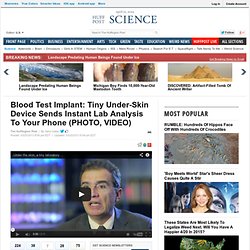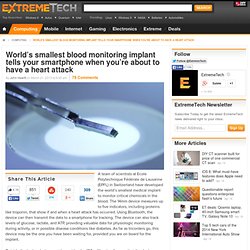

Scientists fit light-emitting bioprobe in a single cell. By Andrew Myers Gary Shambat, Stanford School of Engineering This scanning electron microscope (SEM) image shows a nanobeam probe, including a large part of the handle tip, inserted in a typical cell.

If engineers at Stanford have their way, biological research may soon be transformed by a new class of light-emitting probes small enough to be injected into individual cells without harm to the host. Welcome to biophotonics, a discipline at the confluence of engineering, biology and medicine in which light-based devices – lasers and light-emitting diodes (LEDs) – are opening up new avenues in the study and influence of living cells. The team described their probe in a paper published online Feb. 13 by the journal Nano Letters.
Applications and implications The researchers call their device a "nanobeam," because it resembles a steel I-beam with a series of round holes etched through the center. These are the building blocks for nanoscale lasers and LEDs. Iron to a magnet A clever structure 2 Share. Blood Test Implant: Tiny Under-Skin Device Sends Instant Lab Analysis To Your Phone (PHOTO, VIDEO) Forget the pricks and pains of needles; blood testing may have just gotten a whole lot easier.

Swiss researchers unveiled a prototype for a blood-testing device that lives under the skin during the annual Design, Automation and Test in Europe conference on Wednesday. The tiny blood test implant -- measuring less than half an inch -- analyzes concentrations of substances in the blood, and is capable of instantly sending the results to a user's mobile device, the researchers said in a statement. How exactly does it work? The sensory microchip is surgically implanted in the interstitial tissue, just beneath the skin, and the implant's power source -- two lithium batteries -- is worn over the skin in an attachable patch.
"The chip is placed in the interstitial tissue and it comes in contact with fluids in the body," Dr. Dr. Once implanted, the so-called "tiny laboratory" acquires data from five sensors on the microchip once every 10 minutes in a process called continuous monitoring. World’s smallest blood monitoring implant tells your smartphone when you’re about to have a heart attack. A team of scientists at Ecole Polytechnique Fédérale de Lausanne (EPFL) in Switzerland have developed the world’s smallest medical implant to monitor critical chemicals in the blood.

The 14mm device measures up to five indicators, including proteins like troponin, that show if and when a heart attack has occurred. Using Bluetooth, the device can then transmit the data to a smartphone for tracking. The device can also track levels of glucose, lactate, and ATP, providing valuable data for physiologic monitoring during activity, or in possible disease conditions like diabetes. As far as tricorders go, this device may be the one you have been waiting for, provided you are on board for the implant. Outside the body, a battery patch provides the 100 milliwatts of power that the device requires by wireless inductive charging through the skin. At the moment the device has a limited number of sensors, but there is no theoretical ceiling on this.
Feather-light sensors are as comfy as a second skin - tech - 24 July 2013. Video: Sensing skin could be used as mouth implant A diaphanous plastic sheet peppered with sensors could lead to the development of medical implants so unobtrusive that people scarcely notice them, or provide "sensing skins" for prosthetic limbs or robots.

So say materials scientists led by Takao Someya and Martin Kaltenbrunner at the University of Tokyo in Japan. Their plastics-based circuitry is lighter than a feather and just 1 micrometre thin. It is also so flexible and tough that an implant based on it would be all but imperceptible when worn on the back of your hand, say, or lining the roof of your mouth. "This technology will lead to biomedical sensors that cause no discomfort at all to the wearer," says Someya. The sensors, which have the consistency of plastic food wrap, can be bent, stretched, crumpled and placed in wet environments without affecting their ability to operate – key characteristics of artificial skin designed to sense touch or temperature.
Stretchy circuits.